Málaga, Andalucía 作者: 来源: 发布时间:2021-03-17
1. Population and Area
Pop: 967,250 (urban)
Area: 398 km2 (munip.)
Elev: 11 masl
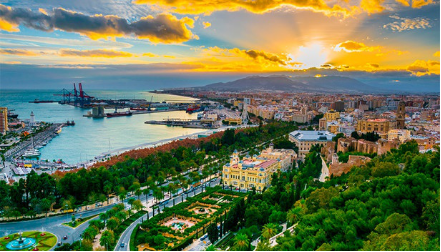
Málaga location in Spain within the community of Andalucía
https://goo.gl/maps/dpAp4pZAqLACFank6
2. Natural geography
Nature and weather
Topography
The municipality of Malaga extends through three natural regions of different landscapes. The urban agglomeration occupies most of the Hoya de Málaga, a coastal alluvial plain formed by the estuaries of the Guadalmedina and Guadalhorce rivers. The northern half and the eastern part of the municipality correspond to the mountainous territory of the Montes de Málaga, which can reach 1032 meters above sea level on the Cresta de la Reina, and to the west the Guadalhorce valley extends.
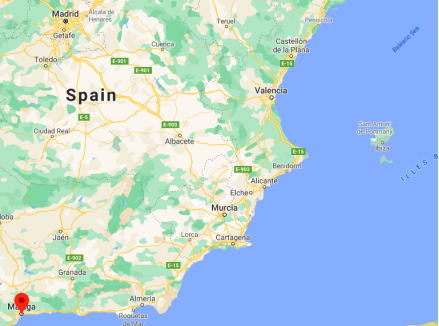
Mountainous profile of the eastern coast of the bay of Malaga seen from the mouth of the Guadalhorce. The snowy peak in the background is La Maroma, in the Tejeda mountain range.
The city is located at an altitude of 8 meters above sea level and opens onto a wide bay surrounded by the southern foothills of the Montes de Málaga, which from the municipality of Rincón de la Victoria, run through the city parallel to the coast in an easterly direction. west and that include the mountains and hills of Calderón, San Cristóbal, Victoria, Gibralfaro, Los Ángeles, Coronado, Cabello, La Tortuga and Atalaya, then continuing inland along the Campanillas river valley. On the western side, the Cártama and Mijas mountains close the bay.
The Malaga coastline has been greatly modified by human action throughout history, with some parts of the city being found on land reclaimed from the sea. In general, the beaches located to the west of the port and the mouth of the Guadalmedina are low and sandy, while towards the eastern side the coast has a more rugged relief, with mountain formations very close to the coast.
Hydrography
The entire municipality falls within the Andalusian Mediterranean Basin. The watercourses are short and span steep slopes, which is why they often cause torrents. The two largest are the Guadalhorce and the Guadalmedina, which collect most of the municipality's water. The irregularity of the rainfall pattern results in the streams being intermittent, often being dry in summer.
Flora and fauna
The origin of most of the arboreal vegetation that covers the municipality is located in the reforestation carried out from the 30s of last century in the Montes de Málaga, in order to preserve the city from the great floods that it suffered from cause of the Guadalmedina river. The species used in these repopulations were stone pine, resin pine and especially Aleppo pine, a species that adapts perfectly to poor and highly eroded soils.
From these repopulations, the native Mediterranean vegetation begins to develop and today you can see holm oaks, cork oaks and gall oaks, as well as chestnut, walnut, poplar, ash, strawberry, myrtle and carob trees, as well as various species of rockrose, heather , labia, palm heart, broom, thyme, rosemary, asparagus, etc. In the clearer areas of the pine forest, the typical Mediterranean scrub develops, with species resistant to droughts such as the erguen, the Moorish gorse, the aladierno and the broom broom. In the shade of this thicket or under the pine forest, species such as kermes oak, torvisco, juniper and white heather develop.
The mouth of the Guadalhorce, a small area of marshes to the south of the city, where the river forks into two arms forming a river delta, contains aquatic plants, perilagunar vegetation of reeds, castanets and almajos mainly, but also poplars, eucalyptus, willows, tapestries and palm trees.
The Montes de Málaga support a large number of animal species. There have been more than 151 species of vertebrates and an even greater number of invertebrates.33 Amphibians include the common frog, the common toad, and the runner toad. Reptiles are represented by 19 species, including the chameleon, a species in serious danger of extinction, the gecko, the ocellated lizard, the lizard and the snakes. Birds represent the largest group of vertebrates with almost 100 species, among which the raptors such as the goshawk, the hawk, the common buzzard, the Bonelli's eagle, the booted eagle, the short-toed eagle, and the sometimes scavengers, kite can be highlighted. royal, black kite, owl, barn owl, scops owl and tawny owl.
Mammals number more than 30 species, including carnivores such as the fox, the badger, the genet, the mongoose, the weasel and the polecat; insectivores such as the Moorish hedgehog, the blind mole, the shrew, the Etruscan shrew, which is the smallest mammal in the world, and the bat; rodents such as the field rat, the gray rat, the common mouse, the field mouse, the water rat, the mole rat, the dormouse, the common vole, the squirrel, the rabbit and the Mediterranean hare; as well as the wild boar, one of the largest mammals that inhabit the mountains of the municipality.
The mouth of the Guadalhorce also contains a rich and varied fauna of birds, reptiles and amphibians, among which the moorish, the flamingo, the spoonbill, the black stork, the Audouin's gull or the red-billed seagull stand out, in addition to other more common ones such as egrets, shearwaters, terns, coots and ducks. Furthermore, the bay of Malaga is a breeding ground for a multitude of underwater species. On its sand, mud and rock bottoms, banks of mollusks such as clams, coquinas, peregrinas and corrucos develop. However, the fishing grounds of Malaga are in serious decline, due to fishing pressure and the poaching of immature fish, the most affected species being anchovies, hake, cane, sardines, red mullet, razor clams, scallops and coquina.
Köppen Classification: Mediterran Climate
Under the Köppen Climate Classification climate classification, "dry-summer subtropical" climates are often referred to as "Mediterranean". This climate zone has an an average temperature above 10°C (50°F) in their warmest months, and an average in the coldest between 18 to -3°C (64 to 27°F). Summers tend to be dry with less than one-third that of the wettest winter month, and with less than 30mm (1.18 in) of precipitation in a summer month. Many of the regions with Mediterranean climates have relatively mild winters and very warm summers.
The Köppen Climate Classification subtype for this climate is "Csa". (Mediterran Climate).
The average temperature for the year in Málaga is 64.4°F (18°C). The warmest month, on average, is August with an average temperature of 77.7°F (25.4°C). The coolest month on average is January, with an average temperature of 53.4°F (11.9°C).
The highest recorded temperature in Málaga is 111.0°F (43.9°C), which was recorded in July. The lowest recorded temperature in Málaga is 27.0°F (-2.8°C), which was recorded in January.
The average amount of precipitation for the year in Málaga is 20.6" (523.2 mm). The month with the most precipitation on average is November with 3.7" (94 mm) of precipitation. The month with the least precipitation on average is July with an average of 0.1" (2.5 mm). There are an average of 43.0 days of precipitation, with the most precipitation occurring in January with 6.0 days and the least precipitation occurring in July with 0.0 days.
In terms of liquid precipitation, there are an average of 72.0 days of rain, with the most rain occurring in April with 9.0 days of rain, and the least rain occurring in July with 1.0 days of rain.
http://www.weatherbase.com/weather/weather-summary.php3?s=28480&cityname=M%E1laga%2C+Andalusia%2C+Spain&units=
Getting there and around
Get there
By plane – Málaga has the fourth biggest international airport (AGP) in Spain, to which many budget airlines fly to. There are even seasonal summer flights to New York.
Public transport from the airport: you can get a train, a bus or a taxi into town, or hire a car. Bus no. A costs €3 and is very convenient, running every 30 minutes and stopping at Alameda Principal and Paseo del Parque, where most of the local buses that serve the city stop as well. The stop names are shown on an electronic display inside the bus so you can tell when to get off. Bus A also stops at the coach station (beside the train station). Note that this bus used to be called nr. 19. The airport's Train station is opposite arrivals terminal 3, trains to Malaga Centro costs €1.80 (May 2019) one way into Malaga Centro (final stop), leaving from Platform 2. It runs every 20 minutes, taking approximately 12 minutes into Malaga Centro.
Walking from the airport: The beach is only 5 km away from the airport. To get there by foot, exit the terminal at the lower level. Walk south-east past the abandoned terminal 1. Cross the N-348 at the roundabout (Dangerous!). Continue south-east along the N-348. At the end of the street turn left and pass underneath the MA-23. Use the footbridge to get on the other side of the N340/MA-21 and continue north-east. After you've crossed the river Guadalhorce, turn right and follow the river on a sand path. You arrive at the mouth of the Guadalhorce after 2 kilometers. From there you can follow the beach for another 5 km until you reach the city centre of Málaga.
Renting a car at Málaga's airport is relatively cheap, but it is advisable to book in advance.
Taxis from the airport charge a minimum airport fare of 17,00 € (fare 1)/19,01 € (fare 2) to any destination.
By bus – The main bus station is right across the street from the train station, a km or so west of the city centre on Paseo de los Tilos. The station serves buses from all over Spain and is a major transfer point if you're passing through this region.
A substation, the Muelle Heredia bus station, is located along Avenida de Manuel Agustin Heredia, adjacent to the port and handles many of the regional buses that serve the Malaga province, such as those going to nearby beach towns, many of which are operated by the Malaga Metropolitan Transport Consortium.
By train – María Zambrano, the city's sleek new railway station, is about a km west of the city centre and served by RENFE's high-speed AVE service, which zips travelers to Madrid in 2.5-3 hours (some with continuing service to Barcelona), Cordoba in 1 hour or Seville in 2 hours, with multiple trains running each line daily. Slower (and cheaper) trains are also available. For Granada, take a train to Bobadilla and change to a Granada-bound train there.
RENFE also operates two Cercanías commuter rail lines out of Malaga, one west along the coast to the airport and the nearby tourist towns of Torremolinos and Fuengirola and one inland. Both lines make two stops in Central Malaga: one at the María Zambrano station (where you can connect to RENFE and the bus station across the street) and one at the end of the line at Centro-Alameda, located closer to the city center where Avenida de Andalucia crosses the Guadalmedina River.
By car – The A-7 E-15 motorway runs along the coast to from Gibraltar to Almeria and through Murcia and on.
The A-45 motorway runs from Cordoba to Malaga.
By boat – There is a ferry route between Málaga and Melilla in North Africa with Transmediterranea.
Rideshare – Check out Blabla Car's carpooling service for rideshare options. A great option if you don't have a driver's license or want to avoid public transport.
COVID19 – International entry into Spain: subject to verification
Domestic travel is not restricted, but some conditions may apply
·Face masks are mandatory
·There is a social distancing requirement of 1.5 metres
·Domestic border crossings may be subject to approval, testing and quarantine
·Nationwide control measures in place
·Some COVID-19 travel conditions may apply in Spain and transport services are subject to change.
Get around
By car – you can rent a car or a bike from various providers.
https://wikitravel.org/en/Malaga
3. GDP
GDP: 29,675 M EUR (2017)
4. Industry characteristics
The most important business sectors in Málaga are tourism, construction and technology services, but other sectors such as transportation and logistics are beginning to expand. The Andalusia Technology Park (PTA) (In Spanish, "Parque Tecnológico de Andalucía"), located in Málaga, has enjoyed significant growth since its inauguration in 1992 by the King of Spain. In 2018, this high-tech, science and industrial park employs over 16,774 workers, according to its own numbers.
In line with the city's strategic plan, the campaign "Málaga: Open for Business" is directed towards the international promotion of the city on all levels but fundamentally on a business level. The campaign places a special emphasis on new technologies as well as innovation and research in order to promote the city as a reference and focal point for many global business initiatives and projects.
Málaga is a city of commerce and tourism has been a growing source of revenue, driven by the presence of a major airport, the improvement of communications, and new infrastructure such as the AVE and the maritime station, and new cultural facilities such as the Picasso Museum, the Contemporary Art Centre and Trade Fair and Congress, which have drawn more tourists.
The city hosts the International Association of Science and Technology Parks (IASP) (Asociación Internacional de Parques Tecnológicos), and a group of IT company executives and business leaders has launched an information sector initiative, Málaga Valley e-27, which seeks to make Málaga the Silicon Valley of Europe. Málaga has had strong growth in new technology industries, mainly located in the Technological Park of Andalusia, and in the construction sector. The city is home to the largest bank in Andalusia, Unicaja, and such local companies as Mayoral, Charanga, Sando, Vera, Ubago, Isofoton, Tedial, Novasoft, Grupo Vértice and Almeida viajes, and other multinationals such as Fujitsu Spain, Pernod Ricard Spain, Accenture, Epcos, Oracle Corporation, Huawei and San Miguel. Nobel prize-winner Bruce Beutler is planning to set up the biggest mutagenesis research laboratory in the world in Malaga.
Key project: Renewable hydrogen project in the port of Malaga
The Buran Energy Group will launch its renewable hydrogen production project in its storage facilities in the port of Malaga throughout 2021, presented to the Malaga Port Authority.
The objective is to improve the energy efficiency of the terminal using hydrogen as an energy vector, through an Artificial Intelligence algorithm that optimizes the constant purchase and sale of renewable energy, as well as the production, storage and supply of green hydrogen.
Renewable or green hydrogen is normally obtained using an electrolysis process that separates the water molecule into oxygen and hydrogen in a gaseous state by means of a continuous electrical current.
The contribution of electrical energy that makes this process possible comes from renewable sources, wind or photovoltaic, among others, so that both production and consumption are neutral with regard to the climate since no polluting gases are emitted in these processes. , as reported by the company in a statement.
Due to its ability to be stored, as gas under pressure or in a liquid state, its use by industry and transportation is expected to increase significantly in the coming years.
Thus, according to the hydrogen roadmap, published in October this year by the Ministry of Ecological Transition and the Demographic Challenge, it is estimated that by 2030 green hydrogen will contribute at least 25 percent of the total hydrogen consumed in the industry.
In addition to the objective of optimizing the energy efficiency of its own facilities, the project promoted by Buran Energy focuses on the simultaneous supply of green hydrogen and electricity through an on-site hydrogeneration for final use in land and maritime vehicles.
The project is part of the organization's plans to develop various lines that provide small industry and fuel supply centers with efficient solutions based on green hydrogen and thus contribute to the decarbonisation objectives set in the 2030 and 2050 Horizon.
https://www.20minutos.es/noticia/4485185/0/buran-energy-desarrollara-el-proyecto-de-hidrogeno-renovable-en-el-puerto-de-malaga
5. Attractions
Alcazaba of Málaga
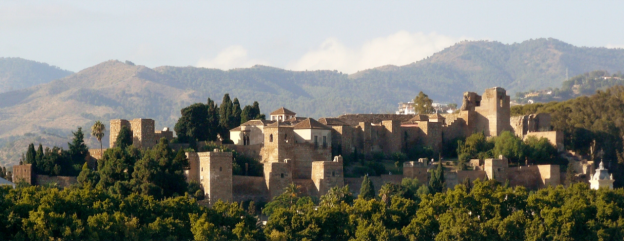
The Alcazaba is a palatial fortification in Málaga, Spain. It was built by the Hammudid dynasty in the early 11th century.
It is the best-preserved alcazaba (from the Arabic al-qasbah, قصبة, meaning "citadel") in Spain. Adjacent to the entrance of the Alcazaba are remnants of a Roman theatre dating to the 1st century BC, which are undergoing restoration. Some of the Roman-era materials were reused in the Moorish construction of the Alcazaba. The Alcazaba was connected by a walled corridor to the higher Castle of Gibralfaro.
Ferdinand and Isabella captured Málaga from the Moors after the Siege of Málaga (1487), one of the longest sieges in the Reconquista, and raised their standard at the "Torre del Homenaje" in the inner citadel.
According to architect restorer, Leopoldo Torres Balbás, the Alcazaba of Málaga is the prototype of military architecture in the Taifa period, with its double walls and massive entry fortifications. Its only parallel is the castle of Krak des Chevaliers in Syria.
The site is very well preserved and maintained. During your visit you’ll discover the courtyards, patios, fountains and sumptuous gardens. As it’s built on a hill overlooking Malaga, it offers a lovely view over the sea and port.
Roman Theater
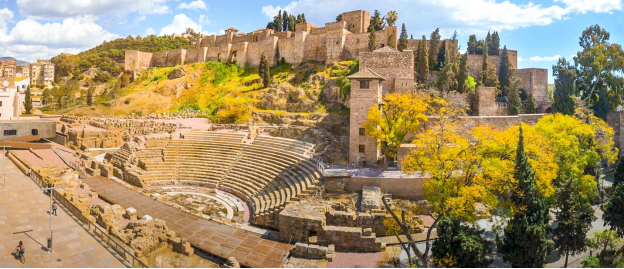
El Teatro Romano is the oldest monument in Málaga City; it is situated in the cultural heart of Málaga city, at the foot of the famous Alcazaba fortress. It is one of the only Ancient ruins left in Málaga after the outwardly Republican city was bombed by Nationalist sympathizers - the Italian army during the Civil war, and one of the only remaining Roman ruins in Andalucía after centuries of warfare, and construction. The site is accompanied by the Centro de Interpretación (visitors centre) which teaches visitors about the history of the ruins and its subsequent excavation.
The theatre was built in the first century BC, under Emperor Augustus, and was used until the third century AD. Subsequently it was left to ruin for centuries, until the Moors settled in Andalucía. In 756-780AD the amphitheatre was used as a quarry by the Moorish settlers , to excavate the stone used to build the Alcazaba fortress - you can see some Roman columns and capitals in the fortress. Over time it became buried under dirt and rubble, and remained hidden there for almost five centuries.
The theatre was rediscovered in 1951, when the construction of Casa de Cultura uncovered the first archaeological clues. The construction of the gardens was abandoned, and instead excavations began. In 1995 a polemic decision was made to demolish the Casa de la Cultura, which stood over a third of the site. Once the site had been fully excavated, a large scale restoration project began, which proved more difficult than anticipated, as many of the missing pieces are now part of the foundations of the neighbouring Alcazaba.
https://www.andalucia.com/cities/malaga/teatro-romano.htm
Pablo Picasso’s House
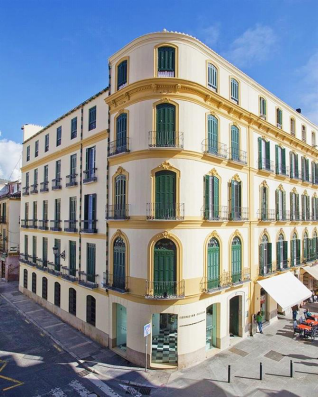
The "Casa Natal" or birthplace of the world famous artist Pablo Ruiz Picasso has been an official heritage site since 1983. It is situated in Plaza de la Merced, in the heart of the historic centre of Malaga. The area is surrounded by monuments from Malaga's rich past such as the Roman Theatre, Gibralfaro Castle with its breathtaking views over the city, as well as the Alcazaba, an Arabian fort which is now home to the Archaeological Museum. It is also just a couple of minutes walk from Malaga Cathedral and literally round the corner from the well known Cervantes Theatre and not far from the larger Picasso Museum.
Built in 1861, Picasso's father, José Ruiz Blasco rented the first floor of the house from 1880 to 1883. Later they lived nearby, still in the Plaza de Merced and it was not until 1891 when Jose Ruiz is offered a job as an art teacher in La Coruña that the family moved to Galicia, where they stayed until 1895.
In 1998 the historic building was taken over by the Picasso Foundation and officially re-opened by the King and Queen of Spain. Since then it has become an important research centre, as well as a monument to the life and work of Picasso and the headquarters for the Picasso Foundation.
On the ground floor is the temporary exhibition hall where you can see interesting artifacts from the beginning of Picasso's home and cultural life. The first floor has many works on show by the artist and his father, Jose Ruiz Blasco, as well as personal mementos of the Picasso family. The third floor is dedicated to the library and Research Centre, with an expansive archive of material on the artist and his work.
As well as Picasso's prints and ceramics, you can see his graphic art from the period 1931 - 1971 and illustrated books. Altogether with some 3,500 examples of contemporary art exhibited by over 200 artists, including a large selection of graphic art by: Miró, Christo, Bacon, Brossa, Ernst, Tápies, Chillida, Plensa, Dokoupil, Guinovart, Matta, Moore, etc. Many contemporary Malaga artists from the 1950's to the present day are represented, such as; Barbadillo, Brinkmann, Peinado, Stefan, Joaquín de Molina, Robert Harvey, Diego Santos, Carlos Durán, Bola Barrionuevo, Chema Lumbreras, Joaquín Ivars y Rogelio López Cuenca. All this, makes a visit to this historic house and art gallery, truly worth visiting.
https://www.andalucia.com/province/museums/picasso-birthplace
Malaga Travel Guide - Top Things to do, Selected by Locals
https://youtu.be/lTp-IhHd3GI
6. History
Phoenicians from Tyre founded a colony named Málaka (Greek: Μάλακα) or Malake about 770 BC. The town controlled access to the Guadalmedina and served as a waypoint on trade routes between Phoenicia and the Strait of Gibraltar. Like other Phoenician colonies, it fell under Carthaginian rule during the 6th or 5th century BC. The Phoenician and Later Roman urban core developed around an area running from the Gibralfaro Hill to the mouth of the Malaca flumen (Guadalmedina).
After the Punic Wars, the Roman Republic took control of the town known to them as Malaca. By the 1st century BC, Strabo alluded to its Phoenician profile, in contrast to the hellenized characteristics of the neighbouring settlement of Mainake.
Transformed into a confederated city, it was under a special law, the Lex Flavia Malacitana. A Roman theatre was built at this time. After the fall of the Western Roman Empire, it was ruled first by the Visigoths. The city was taken circa 552 by the Byzantine Empire; either Malaca or Carthago Nova possibly then becoming the capital of the province of Spania. The Byzantines restored and expanded the docks, thus consolidating the fishing and trading tradition the city already enjoyed. The city was retaken by the Visigoth King Sisebuto in 615. The visigoths ruled the city until the Umayyad Caliphate's conquest of the area in 711.
In the 8th century, the city became an important regional trade center. After its secession from the Abbassid caliphate, the Umayyad Emirate of Cordoba (later Caliphate) ruled over the town known to them as Mālaqah. After the fall of Spain's branch of the Umayyads, Malaqah became the capital of a distinct kingdom ruled by the Zirids. From 1025 it was the capital of an autonomous taifa, until its conquest by the Emirate of Granada in 1239.
The traveller Ibn Battuta, who passed through around 1325, characterised it as "one of the largest and most beautiful towns of Andalusia the conveniences of both sea and land, and... abundantly supplied with foodstuffs and fruits". He praised its grapes, figs, and almonds; "its ruby-coloured Murcian pomegranates have no equal in the world." Another exported product was its "excellent gilded pottery". The town's mosque was large and beautiful, with "exceptionally tall orange trees" in its courtyard.
Málaga was one of the cities of the Iberian Peninsula where Muslim rule persisted the longest. While most other parts of the peninsula had already been won back during the "Reconquista", Malaqah remained part of the Nasrid Kingdom of Granada. Málaga was seized by Christian forces on 18 August 1487, after a 3-month 11 days siege. The Muslim inhabitants resisted assaults and artillery bombardments before hunger forced them to surrender; virtually the entire population was sold into slavery or given as "gifts" to other Christian rulers, five years before the fall of Granada.
On 24 August 1704 the indecisive Battle of Málaga, the largest naval battle in the War of the Spanish Succession, took place in the sea south of Málaga.
After the coup of July 1936 the government of the Second Republic retained control of Málaga. Its harbour was a base of the Republican navy at the beginning of the Spanish Civil War. It suffered heavy bombing by Italian warships which took part in breaking the Republican navy's blockade of Nationalist-held Spanish Morocco and took part in naval bombardment of Republican-held Málaga. After the Battle of Málaga and the Francoist takeover in February 1937, over seven thousand people were killed, as they were trying to flee the city through the road to Almería.
The well-known British journalist and writer Arthur Koestler was captured by the Nationalist forces on their entry into Málaga, which formed the material for his book Spanish Testament. The first chapters of the book include an eye-witness account of the 1937 fall of Málaga to Francisco Franco’s armies during the Spanish Civil War.
The city also suffered shelling later by Spanish Republican naval units. After the war, Málaga and Koestler's old haunts of Torremolinos and the rest of the Costa del Sol enjoyed the highest growth of the tourism sector in Spain.
7. Contact Information
City Mayor: Francisco de la Torre Prados

Phone number: +34 (951) 926 010
Facebook: https://www.facebook.com/pacodelatorrep
Twitter: https://twitter.com/pacodelatorrep
Website: http://www.malaga.eu
Govt. Office Address: Avenida Cervantes, 4. 29016 Málaga, Spain
